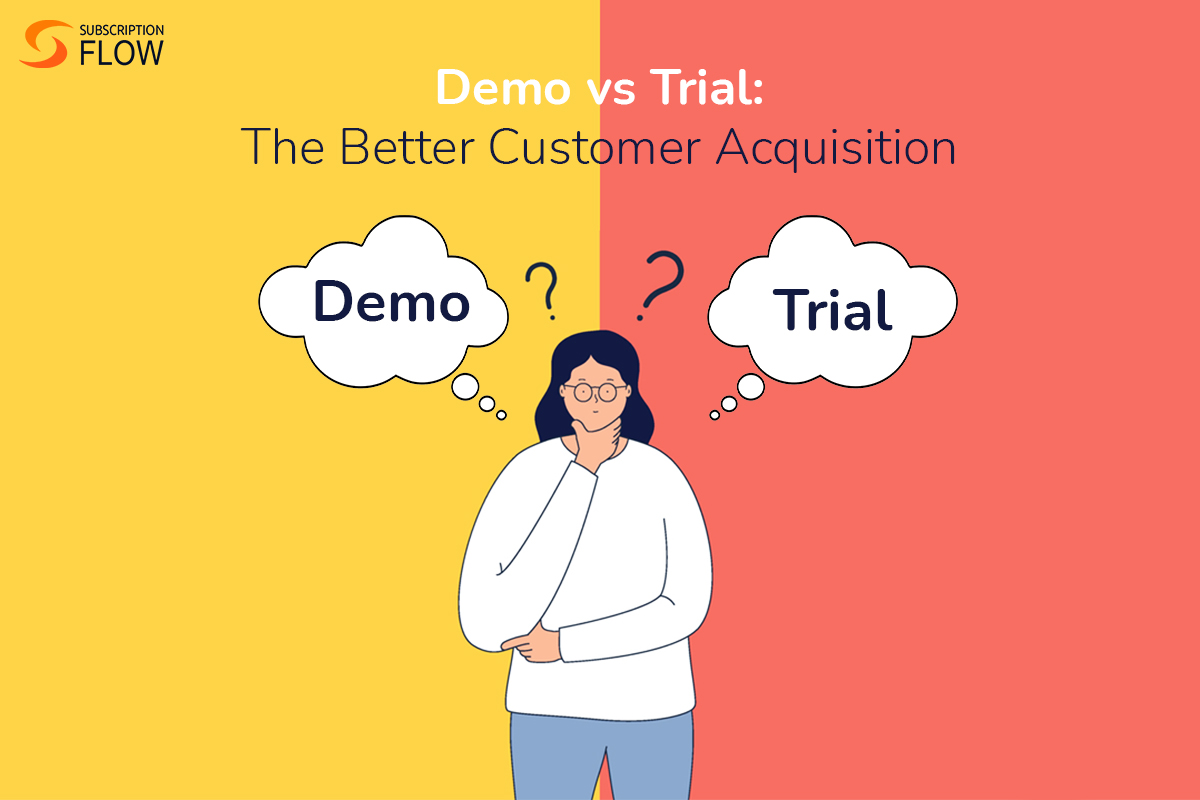
Demo vs Trial: The Better Customer Acquisition Strategy
Demos and trials are both popular customer acquisition strategies utilized by subscription enterprises to move potential leads down their sales funnel. Both demos and trials can be powerful and effective tools to drive customer acquisition, but each approach has its own strengths and weaknesses.
In this blog post, we’ll compare and contrast demo vs trial as acquisition strategies and help you determine which one is better suited to your business.
If you are a subscription business looking to offer free trials and freemiums, consider schedule a demo with one of the best trial management software, SubscriptionFlow.
Demo vs Trial: What are they?
· Offering demos:
A demo typically involves giving customers an overview or demonstration of the product or service you offer.
For B2B SaaS companies a live, one-on-one meeting is the most common format for a demo allowing you to engage and pitch the product catered to the client’s specific pain points and make sure all their questions get answered.
However, if the lifetime value (LTV) of your customers is low or you cannot afford an extensive Sales team, there are other ways to execute a demo. These include a pre-recording video, live webinars, and interactive online previews. Whichever you choose, the function of demos remains the same: to showcase the key features and added value of the product with the goal of generating interest in the offering.
· Offering trials:
A trial involves giving customers the opportunity to use a product or service for a limited period of time (or a limited number of uses) before committing to a purchase. Trials may be completely free or offered at discounted rates. They may also be opt-in (card-less), opt-out (auto-charged), or usage-based.
The goal of a trial is to allow customers to explore the product or service firsthand, enabling them to make an informed purchase with a more substantial lifetime value (LTV) for your business.
Free trials should not be confused with freemiums, which offer an indefinite limited use of the product.
Read More: The SaaS Freemium Model – A Recipe for Success
Both demos and trials can be effective customer acquisition strategies, but they differ in several ways. Let’s make a separate case for each of these strategies.
The Case for Demos
Pros:
1. Cheap and Easy Implementation
One of the main advantages of demo vs free trial is that they are relatively low-cost and easy to implement. Demos can be created quickly with a lot less investment of resources than needed for the trial alternative. Moreover, they can be delivered remotely, offering great convenience to both customers and businesses globally.
2. Lead Generation Tool
Demos can be used as a lead-generation tool. With demos, businesses can nurture prospects interested in learning more about the product or service into potential customers. This becomes particularly relevant for more complex products or services that require more explanation than can be offered in a single sitting. By helping customers understand how the product or service works and how it can benefit them, demos facilitate a process of product discovery designed to end in a purchase.
However, there are also some potential drawbacks to using demos as a customer acquisition strategy.
Cons:
1. No Firsthand Experience for Customers
One of the main challenges faced by demos is that they do not allow customers to experience the product or service firsthand. While a demo can provide a good overview it may not be enough to fully engage customers or convince them to make a purchase. Customers may need more time and interaction with the product or service to truly be convinced of its value.
2. Hard to Stand Out from Competitors
Demos also make it difficult to stand out from competitors likely using similar demo strategies for customer acquisition. In order to be effective, demos need to be engaging and informative, capturing the attention of potential customers and demonstrating the unique value of the product or service. This can be a challenge in a crowded market where competitors are using similar tactics to attract and retain customers.
The Case for Trials
Pros:
1. Firsthand Experience for Customers
Unlike demos, trials allow customers to experience the product or service firsthand before committing to a purchase. This can be a powerful way to build trust and confidence with potential customers, as it allows them to explore your product or service for themselves and see its full value in action, on their own time.
2. Higher Customer Lifetime Value (LTV)
Trials can be effective in overcoming customer objections or concerns, as customers can try out the product or service without paying money upfront. This is particularly relevant to products or services that are more expensive or that require a higher level of investment from customers.
Furthermore, you can enable card-less trials with your subscription management software, for your customers to utilize their trial without needing to provide an authorized payment method. Alternatively, even if they are auto-charged, they can contact you for a refund. All of this allows your customer to feel safe exploring your product or service and pay only when they are ready. This increases their trust and lifetime value (LTV) for your business.
3. Insights from Tracking Trial Usage
A significant advantage to offering trials is that they can be used to collect valuable feedback from customers. With a trial, businesses can gather information about how customers are using the product or service, what they like and don’t like about it, and how it could be improved. This feedback can be used to make changes and improvements to the product or service, leading to higher levels of customer satisfaction and retention over time.
In addition to product-led development, tracking trial usage with subscription management software can help you make personalized offers to drive conversion at the end of a free trial. To illustrate if a customer seems to use one feature heavily, you can safely assume it resolves a pain point and offers them value. Perhaps extending access to that feature, in particular, could increase the likelihood of a conversion at the end of the trial period. Similarly, if a trial user heavily engages with the product, they can be segmented into a high probability of conversion group and incentivized with further provisioning.
Having said that, there are also some potential drawbacks to offering trials as a customer acquisition strategy.
Cons:
1. Higher Cost
One of the main drawbacks of offering trials is that it can be costly and resource-intensive to implement, particularly when offering longer trial periods. In addition to the cost of providing the trial itself, businesses may need to invest in additional resources such as customer support, marketing, and logistics to ensure that customers have a positive experience during the trial period.
2. Lower Customer Lifetime Value (LTV):
Another potential challenge related to trials is that also attract plenty of customers who are not genuinely interested in the product or service. Because trials are often offered for free, some customers may take advantage of the offer without any intention of making a purchase. This can lead to lower conversion rates and can result in a higher cost per acquisition for the business.
Which Strategy Is Better?
Now that we have weighed a few pros and cons associated with trial vs demo strategies, which is better?
The answer, of course, depends on a variety of factors, including the nature of the product or service you offer, your target audience, and the goals of your business.
Case #1: When Demos Work Better
For some businesses, demos may be the better choice. If the product or service is relatively simple and easy to understand, a demo can be a quick and effective way to introduce potential customers to the key features of the product/service and the benefits of doing business with you.
Demos can also be a good option for startups with limited resources, as they are typically more cost-effective and less time-intensive to implement than trials. Demos are also better for B2B SaaS companies where executives prefer talking to a human being before investing in the SaaS solution.
Case #2: When Trials Work Better
For other companies, trials may be the better choice. If the product or service is more complex or requires more time and interaction to fully understand, a trial can be a powerful way to build trust and confidence with potential customers.
Trials can also be effective for businesses that have a high customer lifetime value, as the cost of providing a trial may be offset by the long-term value of the customer. They are also important for companies with aggressive growth goals as demos are not a scalable solution when businesses start to see the hockey stick of exponential growth.
Ultimately, choosing the right customer acquisition strategy relies on understanding your target audience and their needs, and experimenting with different approaches to find what works best for your business. By testing and refining your approach over time, you can find the strategy that delivers the best results and helps you attract and retain customers to actualize scalable growth.
Conclusion
Demos and trials are both powerful customer acquisition strategies that can help businesses attract and retain customers. While each approach has its unique pros and cons, the key to success is understanding your audience and their needs and experimenting with different approaches to find what works best for your business.
Whether you choose to use demos, trials, or a combination of both, the most important thing is to focus on delivering a high-quality experience that meets the needs of your customers. By doing so, you can build trust and loyalty over time, and create a sustainable business that delivers value for years to come.










